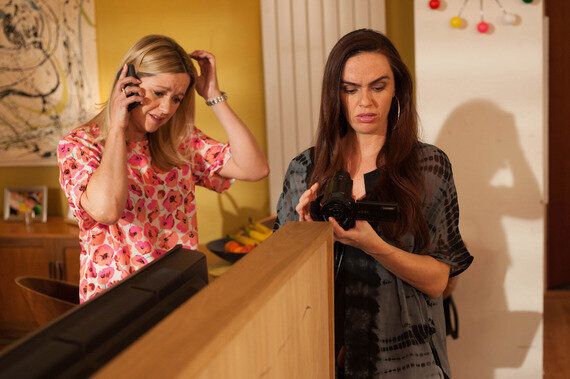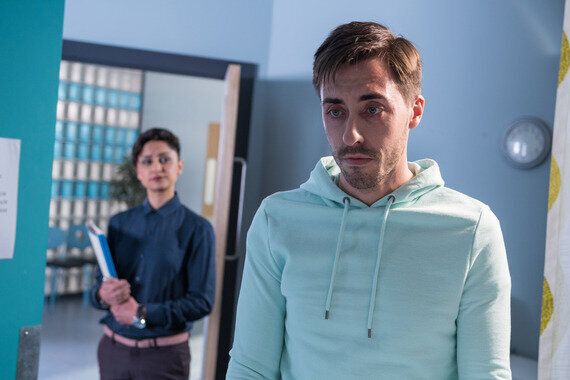I'm going to come clean from the start- I've actually never watched Hollyoaks, well, before today anyway. I suppose I've just never thought it was my kind of TV and I've certainly never thought of a soap as a serious part of the suicide awareness work that many of us carry out.
That all changed when I answered a call from the Hollyoaks press office asking me to watch four episodes before they aired. The story line they wanted my opinion on involves main character Scott Drinkwell, played by Ross Adams, a prominent LGBT+ character. Scott's flamboyant personality has sometimes led him to be ridiculed by his neighbours and even isolated from some of the LGBT+ community. Over the four episodes viewers learn how unhappy Scott is when he tries to take his own life.

Copyright Hollyoaks/Channel 4
I presumed that what I was going to see was a light-hearted take on an extremely serious subject. What I actually witnessed was, in my view, was a remarkable piece of television.
Using Scott's video camera as a way to give us an insight into the cumulative effect of individual interactions during a single day is extremely powerful and conveys how it is often many small events that can lead to a single suicidal act. After my partner Mark took his life, I lost count of the number of people who asked me why. I think they expected there to be one specific reason rather than a build up of seemingly insignificant events. In a powerful monologue, we see Scott's interpretation of the events that over time had affected him and his mental state.

Copyright Hollyoaks/Channel 4
Again, the hospital scenes are dealt with responsibly, with Scott clearly upset or 'shaken up but talking' as his psychologist describes him. Theatrical licence is definitely in play in these scenes, but the overall effect is accurate as Scott tries to explain why he tried to take his own life, but is swayed into saying what he thinks his family and the psychologist wants to hear. In a transition that can, in reality, take weeks, we see Scott realise that, rather than returning home, he does in fact need the clinical help for his depression that is being offered by the in-patient setting. Scott states, "I'm tired of feeling sad and angry and worthless."
One of the most powerful interactions is between Scott and his psychologist. We witness a conversation, that is usually private, during what looks like a risk assessment, and we also see the effect that that interaction has on Scott, but unusually we see a tearful psychologist, clearly affected by their conversation. In depicting this, Hollyoaks is also challenging a myth that clinicians are immune to such interactions and that professionalism is equal to being uncaring and insensitive.

Copyright Hollyoaks/Channel 4
In my experience, the reaction of Scott's family and friends is pretty realistic, which is probably why it was so difficult to watch. They swing between shock and disbelief, "Maybe he's telling us he's fine because he is fine", the misguided anger, "You're a selfish, ungrateful little boy!", and acceptance, and all the things in between seem to be the experience of many. Initially Scott's closest relative, Auntie Diane, presumes that Scott has been attacked and even when it becomes apparent that he has in fact tried to take his life, she swings between reducing his act to attention seeking to promising that the family will support him.
Seeing the interaction between Scott, his family and the clinician is so important in my opinion! As we try and encourage family inclusion in areas of mental health care, especially those transition periods between hospital and home, it's heartening to see all three characters on screen at the same time, with the family being encouraged to do what's best for Scott rather than presuming home is best for him.
The power of storytelling on television is never to be underestimated and using a soap-opera as an opportunity to reach the very audience that suicide awareness campaigns have been trying to reach for years, is nothing short of genius.
Yes, art has always imitated real life and vice versa, but when you have what has been described as a 'public health emergency' depicted in this way, it takes that power on to another level.
According to the LGBT foundation, LGB people are twice as likely as heterosexual people to have suicidal thoughts or make suicide attempts, and LGB people are two to three times more likely than heterosexual people to suffer from depression. With that in mind, the timing could not be better, as it comes ahead of several important anniversaries for the LGBT+ community. In July it will be 60 years since the introduction of the Wolfenden Report, which recommended that 'homosexual behaviour between consenting adults be no longer a criminal offence'. September also marks 50 years since the decriminalisation of homosexuality in The Sexual Offences Act 1967.
Influenced by the guidance of both Mind and the Samaritans, the hope is that the Hollyoaks viewers will gain a better understanding and awareness of important issues that need to be talked about and that those who may have otherwise suffered in silence will reach out and receive the help they need. I suppose the temptation in TV land will be to stop following Scott's progress, but I really hope they don't. I hope the scriptwriters are brave enough to allow viewers to chart Scott's steady progress back into the community that he clearly loves so much.
Congratulations Hollyoaks! You'll never know how many people you've helped.
